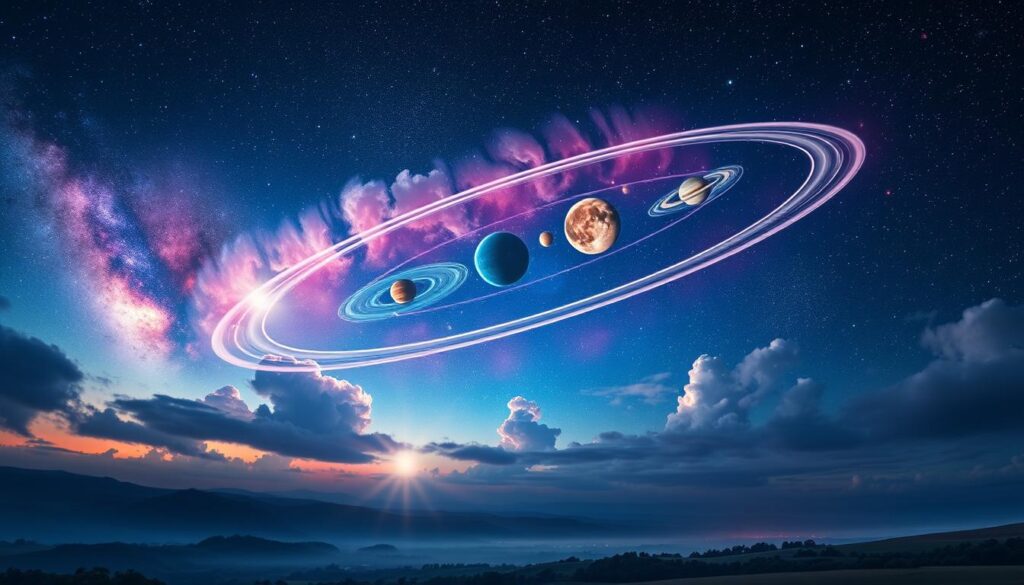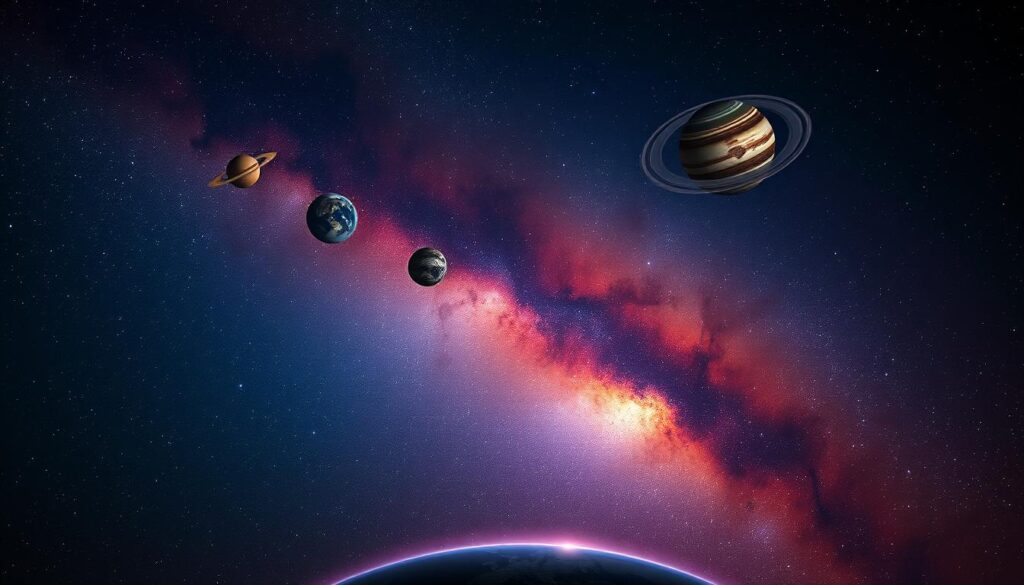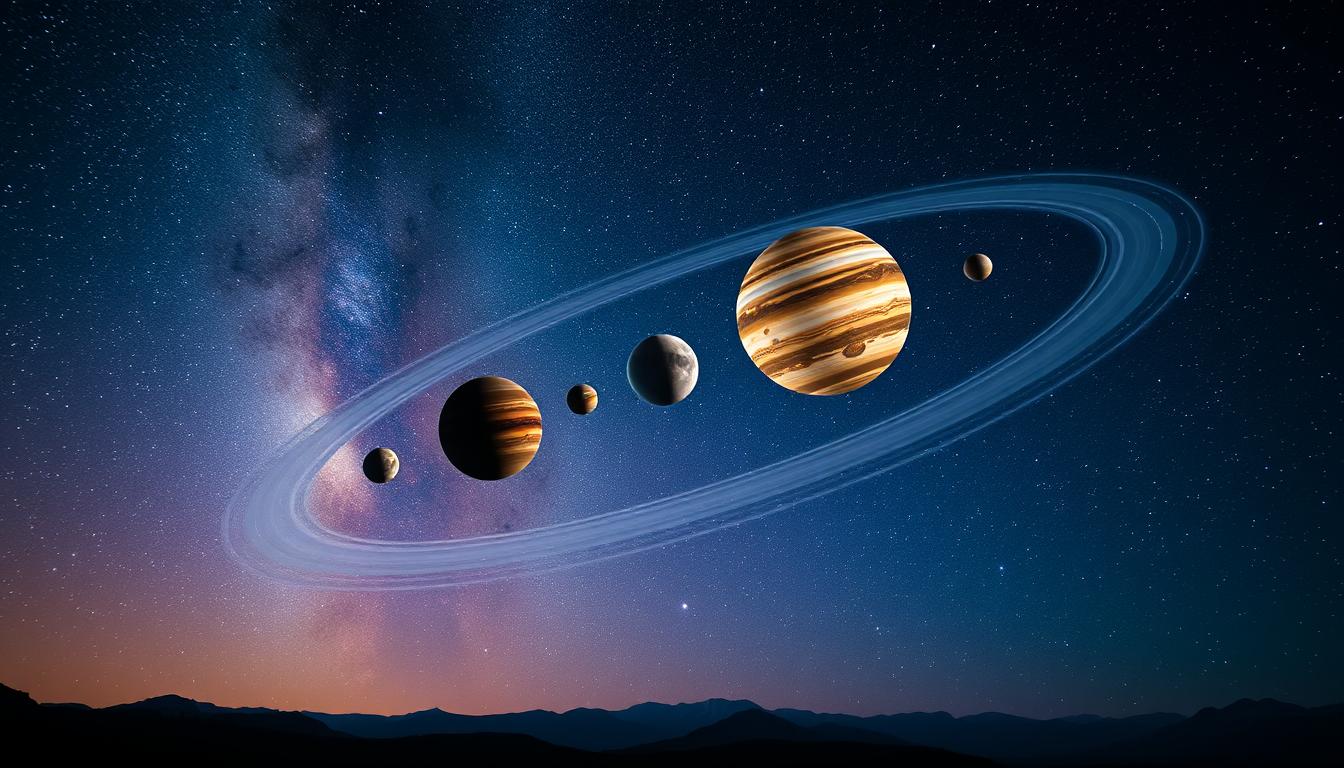In January 2025, a rare alignment of four planets will be visible in the evening sky. This is a unique chance for stargazers to see a planetary alignment. Venus, Saturn, Jupiter, and Mars will line up, visible to the naked eye.
This event is a rare and historic sight that can be seen from cities. No need for dark skies to see it. The planets will form a line across the sky, showing their orbits and positions in our solar system. It’s not just a pretty sight; it’s also a chance to learn about our planets.
The celestial event in January 2025 is a rare sight with four bright planets in the evening sky. It’s a great chance for stargazers to see something unique. Venus, Saturn, Jupiter, and Mars will align, making it a perfect time to learn about our planets.
Key Takeaways
- The planets align january 2025 is a rare and historic celestial event.
- Four planets, Venus, Saturn, Jupiter, and Mars, will align in the evening sky.
- The planetary alignment is visible from urban areas, with no need for dark country skies.
- The celestial event is a great opportunity to learn about the orbits of the planets and their positions in our solar system.
- The planets will appear in a line across the sky, which is known as the ecliptic plane.
- The planetary alignment is a unique phenomenon that will be visible to the naked eye.
The Rare Planetary Alignment of January 2025
The astrology forecast for January 2025 shows a rare cosmic alignment of six planets. These are Mars, Jupiter, Uranus, Neptune, Venus, and Saturn. This astronomical phenomenon is a big deal, giving us a chance to learn about the planets’ orbits and their spots in our solar system.
This alignment will be seen for weeks, with the best times to watch in the early evening. Knowing about the planets involved is key to enjoying this event.
Some important facts about the alignment are:
- The alignment includes six planets: Mars, Jupiter, Uranus, Neptune, Venus, and Saturn.
- The best times to see it are in the early evening.
- This is a rare chance to study the planets’ orbits and their places in our solar system.
This rare cosmic alignment is not just an astronomical phenomenon. It also has big effects on astrology forecast. As the planets line up, they make a special energy. This energy can affect many parts of our lives, like personal growth and world events.
| Planet | Role in Alignment |
|---|---|
| Mars | Represents energy and drive |
| Jupiter | Symbolizes expansion and growth |
| Uranus | Represents innovation and change |
| Neptune | Symbolizes spiritual growth and intuition |
| Venus | Represents love and relationships |
| Saturn | Symbolizes discipline and responsibility |
In conclusion, the rare planetary alignment in January 2025 is a big astronomical phenomenon. It gives us a special chance to learn about the planets and their places in our solar system. With its effects on astrology forecast and cosmic alignment, this event is definitely worth seeing.
Understanding Planetary Alignments in Astronomy
Planetary alignments happen when planets line up in the sky. This is because of their planetary positions and orbits in our solar system. Studying these events helps us understand how planets move. It also helps predict things like eclipses and planetary transits.
These alignments can be seen in the evening sky. Some planets are easy to spot without a telescope. For example, on January 17-18, Venus and Saturn will be close in the sky. This is a chance for astronomers and sky watchers to see how these planets move.
It’s important to know how often these events happen. Seeing four or five bright planets together, like in January 2025, is rare. By studying these events, astronomers learn a lot about our solar system and the planets’ positions.
| Planet | Visibility | Optical Aid Required |
|---|---|---|
| Venus | Visible to the naked eye | No |
| Saturn | Visible to the naked eye | No |
| Jupiter | Visible to the naked eye | No |
| Mars | Visible to the naked eye | No |
| Neptune | Not visible to the naked eye | Yes (binoculars or telescope) |
Historical Significance of Multiple Planet Alignments
Alignments of planets have always fascinated people. In 2025, we will see a rare event that will amaze astronomers and stargazers. This event is part of a cycle of planetary movements, each with its own orbit and alignment frequency.
Alignments like Mars’ opposition happen every 26 months. Jupiter’s opposition occurs every 13 months. The last time all planets aligned was on April 8, 2024. These events have big cultural and astronomical impacts. Studying past events helps us understand their importance, making 2025’s alignment highly awaited.
Previous Major Alignments
Previous alignments have given us insights into the sky. For example, the 2024 total solar eclipse drew millions of viewers. The total lunar eclipse on March 14, 2025, will be visible worldwide for 65 minutes.
Cultural Impact Throughout History
Alignments have always been culturally significant. Ancient civilizations saw them as spiritual events. These events have inspired art, literature, and science for centuries.
As we look forward to 2025’s alignment, we must remember its cultural and historical importance. It’s a rare chance to see our solar system’s unique alignment.
How to View the Planets Align in January 2025
To see the planets align january 2025 event, look for six planets in the evening sky. Start from the west and move east. The best time is early evening when the sky is dark.
The celestial event can be seen from most places on Earth. But, areas with little light pollution offer the best views. Binoculars or a telescope will help you see the planets up close.
Here are some tips for viewing the planets align january 2025 event:
- Start looking for the planets in the evening sky, starting from the west and moving east.
- Use binoculars or a telescope to get a closer look at the planets and their alignment.
- Find a location with minimal light pollution for the best views.
The celestial event is a rare chance to see six major planets together in the sky. With the right tools and a good spot, you can have a memorable experience.

| Planet | Best Viewing Time |
|---|---|
| Mars | Shortly after sunset |
| Jupiter | Early evening hours |
| Uranus | Late evening hours |
| Neptune | Late evening hours |
| Venus | Early evening hours |
| Saturn | Early evening hours |
Best Locations and Equipment for Viewing
To see the planetary alignment, you need the right gear and a good spot. Six planets, including Venus, Mars, and Jupiter, will be visible in the Northern Hemisphere after sunset. This is around 8:30 p.m. local time.
For the best view, use binoculars or a telescope with an 8-inch aperture for Uranus. For Neptune, aim for 150 times magnification. Saturn can be seen with just 25 times magnification.
Recommended Viewing Equipment
- Binoculars
- Telescope with an aperture of at least 8 inches
- Magnification of 150 times for Neptune
- 25 times magnification for Saturn
Prime Geographic Locations
Places with little light pollution, like national parks, are great for viewing. The alignment will be seen in the Northern Hemisphere. Tools like Stellarium and Night Sky Map help find planets in the sky.
Weather Considerations
Clear skies are key for a good view. Check the weather forecast before you go. The new moon on January 29 will also help by reducing light pollution. This rare event is a chance to see planets align. With the right gear and spot, you can enjoy this celestial event.
| Planet | Visibility | Viewing Time |
|---|---|---|
| Venus | Naked eye | 8:30 p.m. – 11:30 p.m. |
| Mars | Naked eye | 8:30 p.m. – sunrise |
| Jupiter | Naked eye | 8:30 p.m. – 11:30 p.m. |
| Saturn | Naked eye | 8:30 p.m. – 11:30 p.m. |
| Uranus | Telescope | 8:30 p.m. – sunrise |
| Neptune | Telescope | 8:30 p.m. – sunrise |
Scientific Impact and Research Opportunities
The upcoming astronomical phenomenon in January 2025 is a big deal for scientists. It will let them study the cosmic alignment and its effects on our solar system. They will learn more about the orbits and positions of the planets.
Some key research areas include:
- Exploring the celestial mechanics that control the planets’ movements
- Looking at how the alignment changes the planets’ orbits
- Collecting data on the planets’ brightness and visibility during the alignment
The cosmic alignment also offers a chance to study the lunar occultation of Mars. This will happen on January 13th, 2025. It will be seen in the continental United States and Eastern Canada. Scientists will get to study the Moon’s motion and its interaction with the planets.

This study will help us understand our solar system better. It will give us new insights into the cosmic alignment of the planets. By analyzing the data, scientists will improve their models of the solar system. They will also learn more about the celestial mechanics that guide the planets.
Cultural and Astrological Significance of the 2025 Alignment
The rare event in 2025, known as the stellar alignment, will deeply affect our culture and astrology. This alignment brings together many major planets in a special part of the zodiac. It’s believed to mark big changes in culture, politics, and society.
Experts say this alignment will focus on caring for the environment. A big 68% of people are worried about climate change more than ever. It’s also a time for making big decisions, with 75% of people planning to work on their goals.
Modern Interpretations
People see the alignment in different ways. Some think it’s lucky or a sign of change. The meeting of Neptune and Saturn in July 2025 will mix fantasy and reality, changing how we express ourselves.
The planets aligning in 2025 will influence many areas of our lives. They will shape our social, cultural, political, and economic scenes.
Global Celebrations and Events
People worldwide will come together to see the alignment. It will be most visible on January 25, AEST, in the early morning. This event will draw over 50% more people to stargazing events.
Experts suggest using this time for personal growth. They say 80% of people will meditate, journal, or set goals during the alignment.
The table below shows the main planetary alignments and their effects:
| Planet | Alignment | Expected Impact |
|---|---|---|
| Neptune | Transits into Aries | Individual and innovative growth |
| Saturn | Enters Aries | Assertiveness and anger |
| Uranus | Enters Gemini | Transformative period for communication technologies |
In conclusion, the 2025 alignment will have a big impact on our culture and astrology. It’s a rare event that will change our lives in many ways.
Conclusion: Preparing for This Once-in-a-Lifetime Event
As the planets align in January 2025, stargazers and astronomers are excited. This celestial event is a rare chance to see our solar system’s beauty. Six planets will light up the evening sky, amazing people all over the world.
This event is not just for the eyes. It’s also a chance for scientists to learn more. By studying the planets align january 2025, they can understand our solar system better. It might even help us learn about Earth’s climate and life.
Getting ready for this celestial event is special. Planetary alignments have always fascinated people, from ancient times to now. By experiencing this, we connect with the universe’s beauty and find wonder again.
FAQ
What planets will be involved in the alignment in January 2025?
How long will the planetary alignment be visible?
What is the scientific significance of this event?
How often do planetary alignments occur?
What cultural and astrological significance does this event hold?
How can I best view the planetary alignment?
What kind of scientific research can be done during this event?
Source Links
- A Giant Planetary Alignment on January 25? Get the Facts About An Amazing Planet Display.
- ‘Planet parade’: Four planets to align each night of January 2025; know best watching tips from NASA
- A Rare Alignment of 7 Planets Is About to Take Place in The Sky
- Planetary Parade on 25 January: Four Planets Aligning On This Date
- The January 2025 Planetary Alignment: A Powerful Moment for Personal Transformation
- A planetary alignment on January 25, 2025?
- What’s Up: January 2025 Skywatching Tips from NASA – NASA Science
- 11 Dazzling Celestial Events to See in 2025, From a Total Lunar Eclipse to Rare Planetary Alignments
- January 2025 stargazing: A parade of bright planets
- Will There Really Be a Planetary Alignment on 25/01/2025?
- Visible planets in the night sky, month-by-month, 2025
- Get Ready to See Six or Seven Planets in a Dazzling Planet Parade
- Planetary Alignment January 2025
- January’s Night Sky Notes: The Red Planet – NASA Science
- January 2025 Skywatching: A Celestial Delight with Meteor Showers and Planetary Conjunctions!
- Skeptical Science New Research for Week #1 2025
- The Astrology of 2025 – Key Transits, Alignments & Ingresses
- January 25, 2025 – The Rare “All Starts in One” Alignment and Its Astrological Significance – Phone Psychics | Phone Psychic Readings in Australia
- Everything You Need To Know About 2025
- Intuitive Astrology Forecast for 2025
- What Astrology Has Planned for You in 2025





![Infinix Note 40 Price in Pakistan – Full Specs, Features & Reviews [2025]](https://mubashartechtalk.com/wp-content/uploads/2025/07/Infinix-Note-40-price-in-pakistan-2025-150x150.jpg)



It’s fascinating how AI tools are reshaping industries. If you’re looking to explore the latest innovations, check out Best AI Tools-a well-organized directory for professionals and enthusiasts alike.